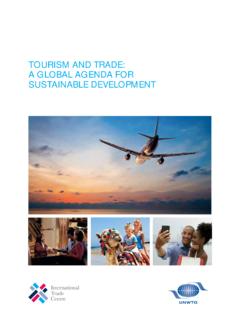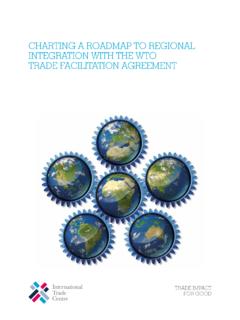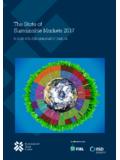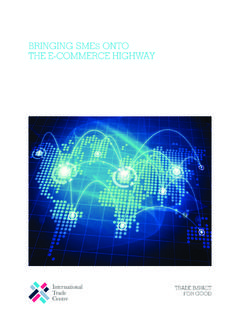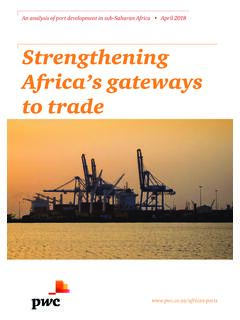Transcription of INTERNATIONAL E-COMMERCE IN AFRICA: THE …
1 trade IMPACTFOR GOODINTERNATIONAL E-COMMERCE IN africa : THE WAY FORWARDINTERNATIONAL E-COMMERCE IN africa : THE WAY FORWARD INTERNATIONAL E-COMMERCE IN africa : THE WAY FORWARD ii Abstract for trade information services ID=43172 2015 C-10 000 INT INTERNATIONAL trade Centre (ITC) INTERNATIONAL E-COMMERCE in africa : The Way Forward. Geneva: ITC, 2015. xii, 47 pages (Technical paper) The paper discussing the barriers hampering development of E-COMMERCE in africa - gives an overview of the E-COMMERCE potential throughout africa ; explores common barriers grouped into four broad areas - financial, infrastructure, socio-political and digital divide, each of which is discussed in a separate chapter; seeks to identify the reasons for these barriers, using insights provided by E-COMMERCE entrepreneurs in several African countries; presents examples of local successes such as Nigeria, alongside examples which illustrate the challenges to replicating such successes elsewhere on the continent; suggests avenues for reducing the obstacles and facilitating INTERNATIONAL E-COMMERCE on the continent; includes endnotes and sources (pp.)
2 45-47). Descriptors: africa ; Electronic commerce , Information and Communication Technologies, SMEs. For further information on this technical paper, contact James Howe English The INTERNATIONAL trade Centre (ITC) is the joint agency of the World trade Organization and the United Nations. ITC, Palais des Nations, 1211 Geneva 10, Switzerland ( ) The designations employed and the presentation of material in this paper do not imply the expression of any opinion whatsoever on the part of the INTERNATIONAL trade Centre concerning the legal status of any country, territory, city or area or of its authorities, or concerning the delimitation of its frontiers or boundaries. Mention of firms, products and product brands does not imply the endorsement of ITC. Digital image on the cover: Shutterstock INTERNATIONAL trade Centre 2015 ITC encourages the reprinting and translation of its publications to achieve wider dissemination.
3 Short extracts of this technical paper may be freely reproduced, with due acknowledgement of the source. Permission should be requested for more extensive reproduction or translation. A copy of the reprinted or translated material should be sent to ITC. INTERNATIONAL E-COMMERCE IN africa : THE WAY FORWARD iii INTERNATIONAL E-COMMERCE IN africa : THE WAY FORWARD iv Foreword The landscape of trade is constantly evolving. And the way that goods and services cross borders is transforming. Businesses today can use the Internet to manage almost every business process, from product sourcing and purchase to financial management, sales, marketing and distribution, cutting down on costs and reaching new markets. The growth of E-COMMERCE is a unique opportunity to open access to INTERNATIONAL markets for small and medium-sized enterprises (SMEs) in developing and least developed countries (LDCs).
4 E-COMMERCE estimated at over US$15 trillion for annual business-to-business transactions and well over US$1 trillion for annual business-to-consumer trade is now business as usual in developed countries. However, this is not the case in many developing countries where use of E-COMMERCE remains low. The current share of consumer E-COMMERCE by African enterprises, for example, is below 2%, and has enormous potential. By 2018, the African E-COMMERCE market is projected to soar to US$ 50 billion, from just US$ 8 billion in 2013. Field experience in developing countries and LDCs confirms that to realize this potential, additional support is required to help SMEs overcome the barriers to trading through online channels and marketplaces. These barriers are not new, but take on greater importance when transactions become digital. Receiving INTERNATIONAL payments is a key part of trade , whether online or offline.
5 Without an INTERNATIONAL bank account or credit card enterprises may not be able to list products on well-known online marketplaces. Some (in particular those for digital goods) may allow enterprises to list products, but exclude them from having an account to receive payments. These restrictions are not the result of government policy or company weakness but are decided by private owners of e-marketplaces and payment platforms, who determine transaction risks. Work is also needed to better position africa as a new source of opportunities and growth for their platforms. Selling online requires enterprises to master information and communications technologies, and develop suitable packaging, attractive product descriptions and well-managed inventory of stock, production and orders. For small enterprises, especially from LDCs, the learning curve is very steep.
6 Getting it wrong can have serious consequences. In a virtual marketplace, meeting consumer needs and expectations becomes even more important. Word of mouth, electronic messaging and buying on the basis of personal recommendation can make or break commercial reputations. These reputations are quickly built and destroyed on the Internet. But using the platforms offers a great opportunity for African businesses, given that many African countries have been quick to adopt mobile technologies, with a young and innovative population of enthusiastic social media users. There is great potential here. INTERNATIONAL E-COMMERCE IN africa : THE WAY FORWARD v This is why ITC s interventions on E-COMMERCE have evolved in recent years, from general awareness-raising to specific support and coaching: taking groups of enterprises through the steps of preparing their goods and services for sale, and accompanying them as they develop their trade through online channels.
7 We sought to learn from the testimonial of managers from across africa . Their own words outline their challenges in selling products and services online. We identified recurrent issues and proposed some practical actions that African firms can take, collectively or with the help of INTERNATIONAL partners. Access to better training and coaching can reduce some barriers. More comprehensive solutions require new forms of partnership and innovative approaches from government, trade and investment support institutions, and enterprises themselves. This paper provides insights to shape such solutions. We hope that businesses in africa interested in taking advantage of E-COMMERCE will be inspired by it. Arancha Gonz lez Executive Director, INTERNATIONAL trade Centre INTERNATIONAL E-COMMERCE IN africa : THE WAY FORWARD vi Acknowledgements ITC would like to acknowledge the support of its parent organizations, UNCTAD and WTO, in their efforts to disseminate understanding and advance the agenda for improving access to E-COMMERCE , in developing countries and beyond.
8 It further acknowledges the work of UNCTAD s ICT Analysis Section in producing the Information Economy Report 2015: Unlocking the Potential of E-COMMERCE for Developing Countries, and UNCTAD s work with ITC on e-business in the context of the World Summit on the Information Society. ITC wishes to thank Usman Ahmed, Head of Global Public Policy at PayPal, for his expert comments and review. The case studies for this paper were developed by Abdel Basset Boulelouah and Mohamed Es Fih, INTERNATIONAL trade Centre. The paper was written by consultant Kim Andreasson under the supervision of James Howe, INTERNATIONAL trade Centre, with writing and editorial contributions from Erica Meltzer. Editorial management and production was led by Natalie Domeisen with Evelyn Seltier. Serge Adeagbo and Franco Iacovino provided digital printing services.
9 INTERNATIONAL E-COMMERCE IN africa : THE WAY FORWARD vii Contents Foreword iv Acknowledgements iv Abbreviations ix Executive Summary xi Chapter 1: africa s e-potential 1 The global context 1 Rising e-potential for africa 4 Nigeria, a regional E-COMMERCE leader 6 Chapter 2: Challenges to INTERNATIONAL E-COMMERCE in africa 9 SME readiness 9 Connectivity 10 SMEs cite barriers 10 Chapter 3: Addressing financial and related barriers 13 INTERNATIONAL payments 13 Regional cross-border initiatives 14 Compliance with financial regulations 15 Gaining consumer trust 17 Chapter 4: Tackling infrastructure barriers 23 Access to affordable broadband 23 Road barriers 25 INTERNATIONAL logistics 26 Chapter 5: Moving beyond sociopolitical barriers 29 Government commitment 29 Sociocultural concerns 30 Access to enabling services from abroad 32 Chapter 6: The remaining digital divide 35 Access to ICTs 36 Using ICTs 37 Digital opportunities: The ultimate barrier?
10 38 Chapter 7: The way forward 41 Appendix: Methodology 43 Endnotes 45 INTERNATIONAL E-COMMERCE IN africa : THE WAY FORWARD viii Tables Table 1: ICT indicators for developed and developing countries 3 Table 2: Regional average values in the UNCTAD B2C E-COMMERCE Index 9 Table 3: B2C E-COMMERCE sales, by region 15 Table 4: B2C E-COMMERCE buyer penetration, by region 15 Table 5: Secure Internet servers, by categories (2014) 18 Table 6: African countries in UNCTAD s B2B index ranking 19 Table 7: Lack of G2B E-COMMERCE and government commitment 30 Table 8: Language disparity in terms of users and content 30 Table 9: A selection of different digital divides facing SMEs in developing countries 35 Figures Figure 1: Global B2C growth, 2014 2020 2 Figure 2: Internet contribution to GDP in selected countries, 2012 4 Figure 3: M- commerce opportunities and concerns in Nigeria 6 Figure 4: The link between E-COMMERCE and concerns about security in Nigeria 17 Figure 5: Data records breached, by sector (2013, %) 18 Figure 6: Fixed-broadband subscription, by level of development 23 Figure 7: Fixed-broadband subscription, by region 24 Figure 8: Modes of mail delivery, by region 26 Boxes Box 1: Defining E-COMMERCE 1 Box 2: A snapshot of SME E-COMMERCE barriers in Tunisia 11 Box 3: A domestic payment solution in Nigeria 14 Box 4: Concerns about cybercrime impeding E-COMMERCE in africa 20 Box 5: Transparency and trust in payments 21 Box 6: Broadband costs in Kenya 25 Box 7: Costly B2C order fulfilment in Morocco 27 Box 8: Finding B2B success but still facing sociocultural barriers 31 Box 9: Made in Morocco: Building an online market presence through resource-sharing 33 Box 10: Unique products, niche markets.


